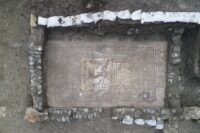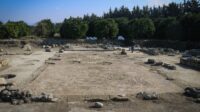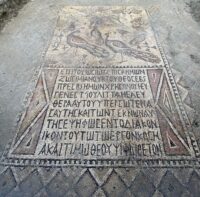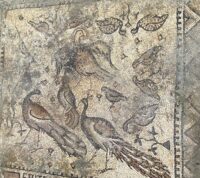 A 6th century mosaic floor featuring peacocks and an Greek inscription has been discovered in Arsuz, a town in Hatay Province, southern Turkey. The floor was part of the Church of the Holy Apostles, a Byzantine-era basilica, and was commissioned by a freed slave who thanked God for his manumission in the inscription.
A 6th century mosaic floor featuring peacocks and an Greek inscription has been discovered in Arsuz, a town in Hatay Province, southern Turkey. The floor was part of the Church of the Holy Apostles, a Byzantine-era basilica, and was commissioned by a freed slave who thanked God for his manumission in the inscription.
The remains of the Church of the Holy Apostles first emerged in 2007 when landowner Mehmet Keleş was planting saplings in his orange grove.  Subsequent excavations revealed a three-aisled basilica church with mosaic floors, stone graves and human remains. A mosaic inscription identified the site as an ancient church dedicated to the apostles. There is evidence it was in use through the 12th century.
Subsequent excavations revealed a three-aisled basilica church with mosaic floors, stone graves and human remains. A mosaic inscription identified the site as an ancient church dedicated to the apostles. There is evidence it was in use through the 12th century.
Located on the Gulf Issus 70 miles from the great city of Antioch, Arsuz was founded during the Hellenistic era and by the 1st century B.C. when it was  annexed by Rome, it was an important port city on the Mediterranean coast of what is today Turkey. It became a regionally significant religious center in late antiquity, the seat of a bishopric and home to a monastery founded in the mountains outside the city by the ascetic hermit Theodosius of Antioch.
annexed by Rome, it was an important port city on the Mediterranean coast of what is today Turkey. It became a regionally significant religious center in late antiquity, the seat of a bishopric and home to a monastery founded in the mountains outside the city by the ascetic hermit Theodosius of Antioch.
The mosaic with peacocks and the inscription were discovered in the most recent dig season and the excavation is ongoing. Eventually, the Hatay regional government plans to build a roof over the remains and open it to visitors as an open-air museum.


The mosaic looks absolutely gorgeous, as does the whole outline of the basilica. How lucky he was to find something like that underneath his oranges!
Swiftly having a look at the inscription, I was unable to find, where it particularly reads of “slaves” nor of “apostles”, but that might have been referred to indirectly. The third line talks of:
“Presb[*]s hemon xrestinou” (elders that are in the know of ἤμων), while in the fifth it reads “soteria” (apparently someone/ -thing is saved), and from the seventh line onwards it reads “diakonikon tou to to ergon kosma kai timo theou (the last word being a verb, something like..) psiph?itheton/ ψιφ?τιθετον” :confused:
…having a second look, having had a cup of coffee, that clearly seems to be an ‘omega’ 😆 Hence, the last word reads “ψιφωθετον” (psiphotheton).
Apart from the meaning of “drizzle”, I found ψηφοθεσμία (psefothesmia = laying a mosaic pavement) and ψηφοθέτης (psefothetes = the layer of the mosaic himself).
:hattip:
…messing with the epsilons and the etas, also with the omegas and omikrons, and –last but not least– even the phis and ypsilons, this is what I would render the text, according to which –unfortunately, my Greek is rusty– this piece would be on a certain “Zosimianos”, who seems to have been a priest and scholar, to save his soul and his works ..leaving aside the ‘litta’ and the ‘deacon’ bit.. laid as a mosaic to adorn the works and the honour of god.
DISCLAIMER: This does not mean that my interpretation is even barely correct, nor who/ where our homie Zosimianos might be. If this really is about a freed slave, an accurate and more complete interpretation will hopefully be published elsewhere, or has been already.
Actually, there are Greek inscriptions, coffins and birds all over the place.
Moreover, the one with the peacocks that I had looked at in greater detail does not even seem to appear on the second ‘bird-view’ picture:
——-
“epi tou o-siot* episkemon zosimianou r tou theos ebs presb[*]s hemon xrestinou neu-genest tou litta n-eleuthera autou hyper soteria se autes kai to teknon autes epsef-osento diakonikon tou-to to ergon kosma kai timo theou psiphotheton”
——-
:hattip:
Dear Henry,
I think that the question of freedom is in “ΗΛΕΥΘΕΡΑ ΑΥΤΟΥ” (Ἐλεύθερα αὐτοῦ ) “his liberty”?
May be we should understand “his liberty” in the sens of : “the liberty his gave”?
What do you think about “ΛΙΤΤΑ” being “λιτά”, a prayer ?
“ΨΗΦΩΣ” is a tessera which is convenient for a text on and about a mosaic.
How do you translate “ΧΡΗΣΤΙΝΟΥ”, I have no satisfying idea ?
I think the end of the text us about the fact that he created a mosaic as modest and useful work of tessarae as a prayer for the liberty he received and the salvation (of Zosimianos?) in the fear of God.
What do you think ?
Dear Calchas, someone is taking notice, at last! :boogie:
The liberation of (his soul?) seems mentioned even twice: Ἐλεύθερα αὐτοῦ/ eleuthera autou ..and that in particular.. (hyper) SOTERIA se autes (kai to teknon autes).
Still, I am not so sure that really Xosimianos laid this (psiphotheton), at least probably not, if he is underneath.
Your point about λιτά(n) (with only one τ), by the way, seems to be a very good one, and it even explains the ‘n’.
What would the (verb?) epsef-osento be, what the (verb?) neu-genest? Could “tou o-siot*” indicate a ‘taphos’ (as episkemon would)?
The bit about “ebs presb[*]s hemon xrestinou” seemed to indicate that he was a elder/ priest (πρεσβύτερος) in the know (Αἵμων xrestinou, but I need to check at home).
Does that sound like ‘Slavery’?. Probably, it was χρήστης (one who gives), χρηστός (useful, good of its kind, serviceable).
Dear Henry,
To me, there is no “N” after”ΛΙΤΤΑ”… I read: “ΛΙΤΤΑ / ΗΛΕΥ-ΘΕΡΑ”, so there is no problem with a “N”.
I do agree, this part of the text lacks of verb…
“ΖΩΣΙΜΙΑΝΟΥ Κ(ΑI?) ΤΟΥ ΘΕΟΣ / ΕΒΖ
ΠΡΕΣΒΖ / ΗΜΩΝ / ΧΡΗΣΤΙΝΟΥ / (Η-E)Υ-
ΓΕΝΕΣ”
-> εὐγενής : noble/well-born ?
I have no clue for ‘ΕΒΖ / ΠΡΕΣΒΖ” (or is “ΕΒΖ” just a mistake ?)
I have an idea for the first line:
“ΕΠΙΤΟΥΩΣΙΩΤ.ΣΕΠΙΣΚΗΜΩΝ”, there are two letters one above the other. I read “ζ” and “ε” but it doesn’t make sens to me.
So I propose: “ἐπί του ὁσιότ(η)ς ἐπί σχῆμῶν”. I understand “about the piety on the sketches” (dedicated to Zosimianos & God).
(Please forgive me if my propositions are dull or stupid, my greek skills are largely improvable).
Dear Henry,
Sorry, I re-read my transcription and there are two letters “ΛΙΤΤΑ ΗE ΛΕΥΘΕΡΑ”. I fact I decided to treat that case like “ΗE”on the previous line (third line, penultimate letter) which looks like an error: he started an eta and realise he needed an espilon: the two letters are merged.
may be we should consider that the text is structured like this :
“for all the reasons and because of this and this” I created this mosaic (ΨΙΦΩΘΕΤΟΝ). Hence, we have only one verb at the very end of the text.
To me there are two different things:
+ Ἐλεύθερα which is liberty by opposition to slavery
+ σωτηρία which is the salvation of the soul
As this is an early christian text, it could make sens to make a difference between physical and spiritual freedom.
Dear Calchas,
I cannot really prove that your “ἐπί του ὁσιότ(η)ς ἐπί σχῆμῶν” is wrong (frankly, lacking the ability and energy to do so), but I try once more…
(in installments, if necessary, and there might be errors, but I wont necessarily correct them myself. …I am exhausted :chicken: ):
—————–
ἐπι-τ(aphos?) οῦσώσίωτ* επίσκημων ζωσίμίανοῦ κ(αί) τοῦ θεοσέβ*s πρεσβυ*s ἤμων χρήστίνου ἤ εὐγενήςτ τοῦ λι(t)τα ἤ ἐλευθερία αὑτοῦ ὑπέρ σώτερια σε ἀυτεσ καί των τέκνων ἀυτήσ ἑψί-φῶς-ento διακονικον τοῦ-to το ἔργον κοσμα καί τιμo θεού ψιφωθετον.
—————–
To the everlasting memory hosting Zosimianos likewise (our) servicing priest, honorable elder also well born also a prayer and to his salvation through his redemption and his works, a bright man and lovable deacon, laid as a mosaic ornamenting the honorable work of God.
—————–
HINTS:
——
δυσίωτος = not easily rusted
θεοσέβεια = service (to God)
(ἐν)επίσκημμα = claiming of property alleged to belong to the state (unsure, if he is buried there, I chose ‘hosting’)
:hattip:
Thank you 😊
ἐπὶ τοῦ ὡσιωτ(άτου) ἐπισκό(που) ἡμῶν
Ζωσιμιάνου κ(αὶ) τοῦ θεοσεβ(ου)ς πρεσβ(εω)ς ἡμῶν Χρηστίνου
ἡ εὐγενεστάτου Λίττα ἡ ἐλευθέρα αὐτοῦ ὑπὲρ σωτηρίας
αὐτῆς καὶ τῶν τέκνων αὐτῆς ἐψώφησεν τὸ διακονικόν.
Τοῦτω! Τὼ! ἔργον Κόσμα καὶ Τιμω!θέου ψι!φοθετόν